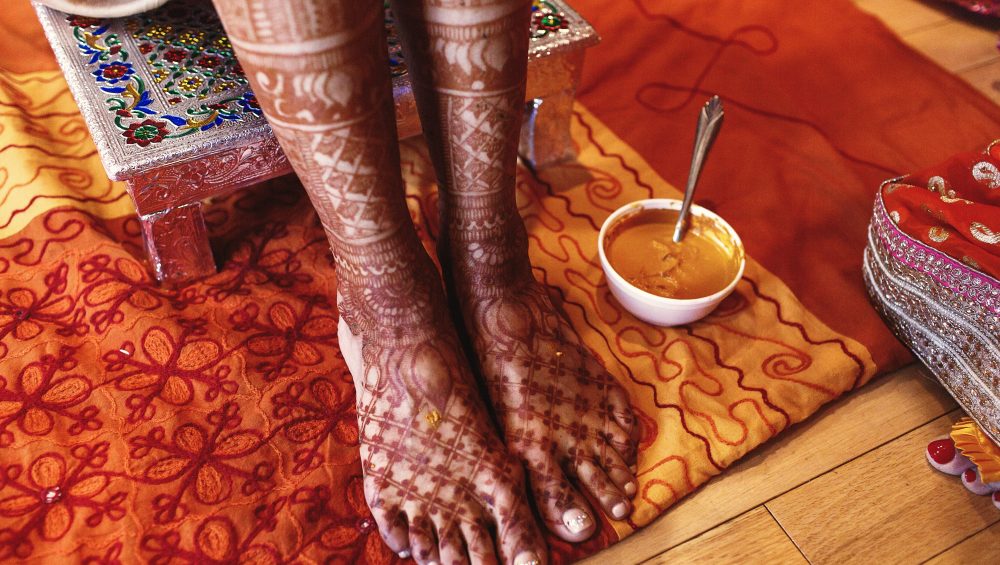Feet mehndi design—or simply foot mehndi—is an elegant and increasingly popular way to adorn the lower part of the body, especially during weddings, festivals and special occasions. While hand mehndi has always been in the limelight, the artistry on feet offers a unique canvas: the toes, the instep, the arch, and the ankle all provide zones to explore.
In recent years, there’s been a strong move towards simple mehndi designs for feet—minimal, clean, and chic—with many brides and mehndi lovers opting for lighter, quicker-to-apply patterns rather than heavy full-feet coverage. According to one trend report, “less is more” for 2025 when it comes to foot mehndi.
Here we’ll explore the latest foot mehndi design trends, break down style-ideas and practical tips, and give some simple design suggestions you can try or ask your mehndi artist for.
Why Choose Foot Mehndi?
- Feet are visible when wearing sandals, ethnic footwear or traditional outfits, making them a great area to showcase henna art.
- For brides or party-goers whose outfit length reveals ankles/feet, foot mehndi enhances the overall look and coordinates beautifully with anklets or toe rings.
- Simple foot mehndi designs often take less time and cause less discomfort (you’re not sitting with your hands raised, for example) – a big plus for minimal-design lovers.
- From a cultural point of view, mehndi (henna) applied on the feet holds significance in many South Asian wedding and festive rituals. (The plant-based paste “henna” used to stain skin is rooted in long traditions.)
2025 Trends in Foot Mehndi Design
Here are some of the hottest trends for foot mehndi design this year:
1. Floral Elegance
Delicate flower motifs, vines and leaves continue to dominate. These designs bring a timeless appeal and suit almost any outfit. As noted in a 2025 trend list: “Floral elegance … delicate flowers with fine detailing are a top choice.”
2. Geometric & Minimalist Lines
A modern departure from heavy motifs: straight or curved lines, triangles, squares, spaced-out dots. These give a chic look with less time and effort. “Minimalist lines” emerged as a major trend.
3. Arabic-Inspired Designs
Flowing swirls, bold outlines, paisley motifs and open spaces characterise Arabic-style mehndi. On the feet, such designs often wrap around the instep and toes. According to a trend article, Arabic-inspired patterns are being reinterpreted in 2025.
4. Mandala & Centralised Motifs
A large circular mandala in the centre of the foot or on top, with smaller supporting motifs on toes or sides, is very trendy. They tend to give a focal design element.
5. Jewellery-Inspired & Anklet Effects
Rather than full coverage, some designs mimic anklets, toe-chains or foot jewellery in mehndi form. This gives a subtle yet decorative effect. From the minimal designs article: “mimicking the traditional anklet… this simple mehendi design for feet is super trendy.
6. Nature-Inspired (Leaves, Vines, Butterflies)
Shapes inspired by nature are being used to keep things fresh yet meaningful. From leaves creeping along the side arch to butterflies near the heel, they add a soft artistic touch.
How to Choose the Right Simple Mehndi Design for Your Feet
When picking a foot mehndi design, take into account:
- Occasion: For a wedding, you might aim for fuller coverage; for a casual event, you can go minimal.
- Outfit & Footwear: Are you wearing open sandals, closed footwear or just slippers? The visibility of the design matters.
- Time & Comfort: A simpler design means less time sitting, less fuss and perhaps a better stain outcome. A minimal design is recommended if you’re tight on time.
- Skin tone & contrast: Using darker henna paste and allowing it to deepen gives better visibility, especially on feet.
- Match with hand mehndi (if any): If your hands have heavy mehndi, you may want a lighter feet design for balance, or mirror style.
- Anatomy of the feet: Consider toes, instep, sides, and heel. Some designs look great on toes alone or on the side of the foot.
- Maintainable size: High-traffic areas like toes and heels may smudge faster — simpler or smaller motifs are easier to preserve.
Simple Mehndi Design Ideas for Feet
Here are some practical, easy-to-execute ideas of foot mehndi design focusing on simplicity and style.
Idea 1: Toe Cluster + Single Vine
Focus the design around the toes: small floral or swirl motifs on each toe, and a vine running up the instep or side. Leaves lots of negative space for simplicity.
Idea 2: Anklet Style Band
Draw a band around the ankle like an anklet, perhaps with a small drop ornament on the foot top. Simple, elegant and easy to apply.
Idea 3: Central Mandala with Minimal Fill
A single mandala on the top of the foot, with the toes either blank or decorated in a small way. Keep the surrounding area clear for emphasis and minimalism.
Idea 4: Side Foot Vine + Dots
Design along the side of the foot (arch area) – a flowing vine or leaf pattern, with small dots on the toes and maybe around the ankle. Very subtle and ideal for casual occasions.
Idea 5: Toe-Only Design
For a super-quick and subtle option: decorate just the toes (and possibly little dots on top of the foot). Great if you don’t want a full feet pattern but still some mehndi.
Additional Read: Top 8 Wedding Flower Gate Decoration Ideas
Step-by-Step Tips for Application & Aftercare
- Prep the skin: Wash feet, exfoliate gently to remove dead skin so the mehndi paste sits well. Dry thoroughly.
- Choose a good quality henna paste: A Darker stain is better and lasts longer. Natural henna is best.
- Start with an outline: If doing your own design, mark a faint outline with a light shade and then fill. On the feet, keep curves smooth to match the shape of toes and instep.
- Keep it simple: For a beginner or minimal look, avoid overcrowded motifs. Use space wisely – negative space (bare skin) adds elegance.
- Let it dry and set: Once applied, let the mehndi dry for at least 30-60 minutes. Avoid smudging.
- Aftercare for better stain: After drying, wrap lightly with tissue or cloth (optional), avoid water for the next few hours. The stain will darken over 24-48 hours.
- Moisturise: Use oil or balm on the design once dry to protect the pattern from fading quickly.
- Avoid heavy footwear immediately after application to prevent rubbing. Sandals or barefoot indoors are ideal.
- Touch‐ups: If some areas are light, a mehndi artist can go back and add small touches.
Final Thoughts
The art of foot mehndi design is evolving – from heavy bridal full-foot coverage to lighter, more modern, and chic patterns that fit diverse tastes and occasions. If you’re looking for simple mehndi designs for feet, focus on clean lines, elegant motifs, and meaningful placement rather than covering every inch.
Whether you choose a floral vine, a minimal anklet band, a mandala, or a toes-only design, the goal is to enhance your look without overwhelming it. The design should complement your outfit, your footwear, and your comfort level. With thoughtful placement and quality henna, your feet will look beautifully adorned for any event.



